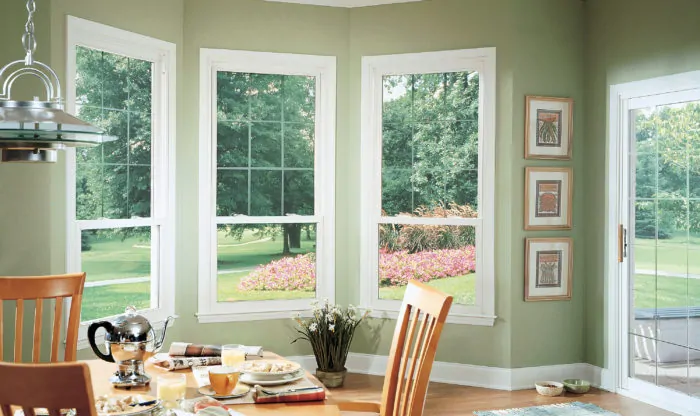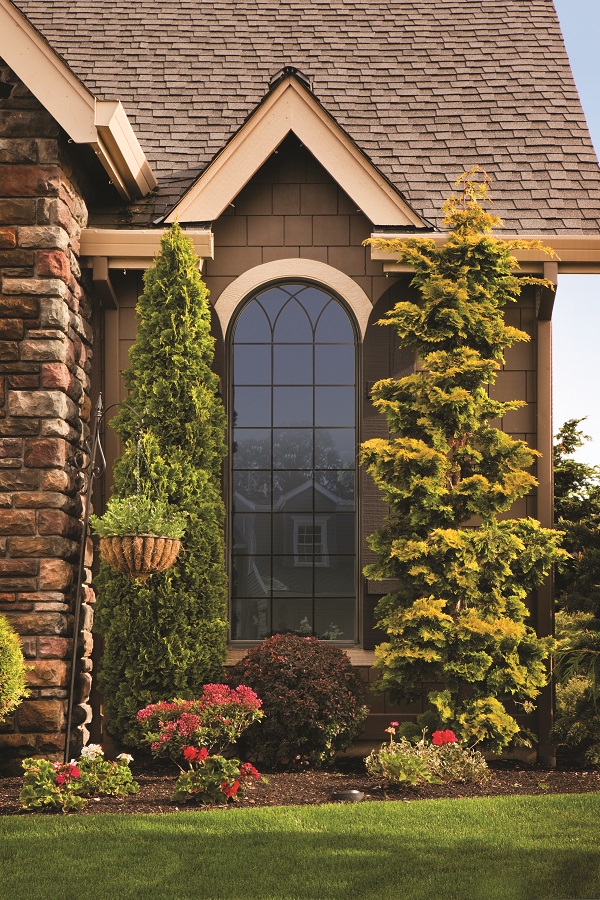Vinyl windows offer homeowners extensive color customization options that extend far beyond the traditional white frame. Modern manufacturing techniques allow for a diverse palette of colors, finishes, and textures that can complement any architectural style while maintaining the durability and energy efficiency that make vinyl windows a popular choice. Today’s vinyl window options provide the flexibility to enhance your home’s curb appeal without sacrificing performance or requiring ongoing maintenance.
Options for Vinyl Window Colors
There are a wide range of colors available in vinyl windows as vinyl can be manufactured in numerous hues and finishes through advanced coloring processes. The material’s versatility allows manufacturers to create consistent coloration throughout the entire window frame, eliminating the need for painting or staining while providing long-lasting color retention that resists fading, chalking, and weathering over time.
Solid Color Finishes
Vinyl windows are available in four primary solid color options that provide clean, uniform appearance across all window components. White remains the most popular choice, offering timeless appeal and compatibility with any architectural style. This neutral option reflects heat effectively and maintains its appearance over time without significant fading or discoloration.

Beige presents a warmer alternative to white while maintaining versatility across different home exteriors. This soft, neutral tone complements earth-toned siding, brick, and stone facades particularly well. The color provides subtle contrast against lighter trim while remaining understated enough not to dominate the overall design scheme.
Almond offers a slightly deeper neutral tone that bridges the gap between beige and cream colors. This option works exceptionally well with traditional and transitional home styles, providing enough warmth to soften stark white exteriors while remaining light enough to reflect heat efficiently.
Desert Clay represents the boldest of the solid color options, delivering rich, earthy tones that complement southwestern architecture and homes with warm-toned exteriors. This color choice adds character and depth to window installations while maintaining the practical benefits of vinyl construction.
Wood Grain Textures
Wood grain vinyl windows feature embossed surface textures that replicate the natural appearance of real wood. These options combine the low-maintenance benefits of vinyl with the aesthetic appeal of traditional wood windows. The textured surface creates visual depth and authentic wood-like character without requiring the ongoing maintenance that natural wood demands.

High-Performance Exterior Finishes
Three specialized exterior finishes are engineered for enhanced durability and distinctive appearance. Black exterior finish creates dramatic contrast and modern appeal, particularly effective on contemporary homes with light-colored siding or when used as accent windows on traditional facades.

Architectural Bronze provides sophisticated metallic tones that complement both traditional and contemporary designs. This finish appeals to homes with stone, brick, or earth-toned exteriors where bronze tones create harmonious color relationships.
Silver finish delivers clean, contemporary aesthetics with excellent heat reflection properties. This option works particularly well on modern architectural styles and provides striking contrast against dark exterior materials while maintaining energy efficiency through superior solar heat reflection.
Dual Color Vinyl Windows
Dual-color vinyl windows feature different colors on the interior and exterior surfaces of the frame, providing design flexibility while addressing distinct aesthetic needs for each side of the window. These windows typically feature a colored exterior finish paired with a white interior, though the specific configuration varies by manufacturer. This dual-color approach allows homeowners to select bold exterior colors that complement their home’s architectural style while maintaining bright, neutral interiors that enhance natural light and coordinate with interior decor.
The dual-color construction process involves manufacturing the vinyl frame components with different pigmentation on each side, creating a permanent color differential that will not fade or wear off over time. These windows differ from two-tone designs in that they do not feature multiple colors on a single surface, but rather distinct colors for interior versus exterior applications. This configuration provides practical benefits, as darker exterior colors can better complement bold architectural choices while white interiors reflect more light into living spaces and maintain versatility across different interior design schemes.
Differences From Standard White Vinyl Windows & Colored Windows
Performance differences between white and colored vinyl windows stem primarily from thermal behavior characteristics. Dark colors like black, brown, and bronze absorb more heat rather than reflecting it, while white windows reflect solar heat away from the frame. Vinyl can warp at temperatures of 140 degrees Fahrenheit and above, making darker colored windows more susceptible to heat-related deformation during normal summer conditions. This heat absorption increases interior temperatures and can compromise the structural integrity of the frame over time.
Colored vinyl windows often require enhanced engineering to compensate for increased thermal stress. Many black windows incorporate advanced energy-efficient features specifically designed to offset potential increased heat absorption. Manufacturing processes also differ between standard and colored options. Solid vinyl achieves color through pigments added during production and performs better with lighter colors, while laminated vinyl uses hot-glued laminates applied after extrusion.
Maintenance requirements vary between colors, as bright debris like pollen becomes more obvious on white windows, requiring more frequent cleaning. Cost considerations also apply since colored vinyl windows typically command higher prices due to specialized manufacturing processes and materials needed to address thermal performance challenges. Standard white vinyl windows remain the most accessible option for their proven performance, lower cost, and universal compatibility with diverse architectural styles.
Frequently Asked Questions: Vinyl Window Colors
Our most frequently asked questions when discussing window colors with homeowners:
What is the most popular color for vinyl windows?
White is the most popular color for vinyl windows, as it has been the standard and most cost-effective choice for homeowners for many years. Most manufacturers offer white as their base color option because it is versatile, timeless, and complements any home interior and exterior style.
Do colored vinyl windows cost more?
Colored vinyl windows typically cost 10-20% more than standard white vinyl windows due to the additional manufacturing processes and specialized pigments required. The exact price difference varies by manufacturer and color selection, with some premium or custom colors at higher costs.
Transform Your Home with Premium Replacement Windows
Are you ready to upgrade your home’s energy efficiency and curb appeal? DaBella’s Glasswing vinyl replacement windows combine superior performance with stunning aesthetics, available in multiple colors to complement your home’s unique style.
Why Choose Glasswing Vinyl Windows?
Our energy-efficient Glasswing vinyl windows are ENERGY STAR rated, and our extensive color selection ensures perfect design coordination. Every installation is handled by certified professionals using premium materials backed by our satisfaction guarantee, delivering lasting durability built to perform for decades.
Do not wait to enhance your home’s comfort, beauty, and value. Our experienced team will guide you through every option to find your perfect window solution. Get a free quote today by calling us at 844-DaBella or schedule online.

